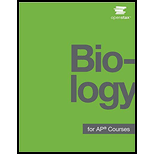Solutions for BIOLOGY FOR AP COURSES (OER)
Problem 1VCQ:
Figure 7.11 Dinitrophenol (DNP) is an "uncoupler" that makes the inner mitochondrial membrane...Problem 2VCQ:
Figure 7.12 Cyanide inhibits cytochrome c oxidase, a component of the electron transport chain. If...Problem 3VCQ:
(Figure 7.14) Tremetol, a metabolic poison found in the white snake root plant, prevents the...Problem 5RQ:
A reducing chemical reaction. reduces the compound to a simpler form adds an electron to the...Problem 6RQ:
During the second half of glycolysis, what occurs? ATP is used up Fructose is split in two ATP is...Problem 7RQ:
What is removed from pyruvate during its conversion into an acetyl group? oxygen ATP B vitamin...Problem 8RQ:
What do the electrons added to NAD+ do? They become part of a fermentation pathway They go to...Problem 9RQ:
GTP or ATP is produced during the conversion of isocitrate into ketoglutarate succinyl CoA into...Problem 10RQ:
How many NADU molecules are produced on each turn of the citric acid cycle? one two three fourProblem 12RQ:
Chemiosmosis involves. the movement of electrons across the cell membrane the movement of hydrogen...Problem 13RQ:
Which of the following fermentation methods can occur in animal skeletal muscles? lactic acid...Problem 14RQ:
A major connection for sugars in glycolysis is ____ ___________ . glucose-6-phosphate...Problem 15RQ:
Beta-oxidation is. the breakdown of sugars the assembly of sugars the breakdown of fatty acids the...Problem 16RQ:
The effect of high levels of ADP is to__inv __ cellular respiration. increase the activity of...Problem 17RQ:
The control of which enzyme exerts the most control on glycolysis? hexokinase phosphofructokinase...Problem 18CTQ:
Why is it beneficial for cells to use ATP rather than energy directly from the bonds of...Problem 19CTQ:
Nearly all organisms on Earth carry out some form of glycolysis. How does this fact support or not...Problem 20CTQ:
Because they lose their mitochondria during development, red blood cells cannot perform aerobic...Problem 22CTQ:
How do the roles of ubiquinone and cytochrome c differ from the roles of the other components of the...Problem 23CTQ:
What accounts for the different number of ATP molecules that are formed through cellular...Browse All Chapters of This Textbook
Chapter 1 - The Study Of LifeChapter 2 - The Chemical Foundation Of LifeChapter 3 - Biological MacromoleculesChapter 4 - Cell StructureChapter 5 - Structure And Function Of Plasma MembranesChapter 6 - MetabolismChapter 7 - Cellular RespirationChapter 8 - PhotosynthesisChapter 9 - Cell CommunicationChapter 10 - Cell Reproduction
Chapter 11 - Meiosis And Sexual ReproductionChapter 12 - Mendel's Experiments And HeredityChapter 13 - Modern Understandings Of InheritanceChapter 14 - Dna Structure And FunctionChapter 15 - Genes And ProteinsChapter 16 - Gene ExpressionChapter 17 - Biotechnology And GenomicsChapter 18 - Evolution And The Origin Of SpeciesChapter 19 - The Evolution Of PopulationsChapter 20 - Phylogenies And The History Of LifeChapter 21 - VirusesChapter 22 - Prokaryotes: Bacteria And ArchaeaChapter 23 - ProtistsChapter 24 - FungiChapter 25 - Seedless PlantsChapter 26 - Seed PlantsChapter 27 - Introduction To Animal DiversityChapter 28 - InvertebratesChapter 29 - VertebratesChapter 30 - Plant Form And PhysiologyChapter 31 - Soil And Plant NutritionChapter 32 - Plant ReproductionChapter 33 - The Animal Body: Basic Form And FunctionChapter 34 - Animal Nutrition And The Digestive SystemChapter 35 - The Nervous SystemChapter 36 - Sensory SystemsChapter 37 - The Endocrine SystemChapter 38 - The Musculoskeletal SystemChapter 39 - The Respiratory SystemChapter 40 - The Circulatory SystemChapter 41 - Osmotic Regulation And ExcretionChapter 42 - The Immune SystemChapter 43 - Animal Reproduction And DevelopmentChapter 44 - Ecology And The BiosphereChapter 45 - Population And Community EcologyChapter 46 - EcosystemsChapter 47 - Conservation Biology And Biodiversity
Book Details
Biology for AP Courses covers the scope and sequence requirements of a typical two-semester Advanced Placement biology course. The text provides comprehensive coverage of foundational research and core biology concepts through an evolutionary lens. Biology for AP Courses was designed to meet and exceed the requirements of the College Board's AP Biology framework while allowing significant flexibility for instructors. Each section of the book includes an introduction based on the AP curriculum and includes rich features that engage students in scientific practice and AP test preparation; it also highlights careers and research opportunities in biological sciences. Advanced Placement and AP are trademarks registered and/or owned by the College Board, which was not involved in the production of, and does not endorse, this textbook.
Sample Solutions for this Textbook
We offer sample solutions for BIOLOGY FOR AP COURSES (OER) homework problems. See examples below:
Chapter 1, Problem 1VCQChapter 2, Problem 1VCQChapter 3, Problem 1VCQChapter 4, Problem 1VCQChapter 5, Problem 1VCQChapter 6, Problem 1VCQChapter 7, Problem 1VCQChapter 8, Problem 1VCQChapter 9, Problem 1VCQ
Chapter 10, Problem 1VCQChapter 11, Problem 1VCQChapter 12, Problem 1VCQChapter 13, Problem 1VCQChapter 14, Problem 1VCQChapter 15, Problem 1VCQChapter 16, Problem 1VCQChapter 17, Problem 1VCQChapter 18, Problem 1VCQChapter 19, Problem 1VCQChapter 20, Problem 1VCQChapter 21, Problem 1VCQChapter 22, Problem 1VCQChapter 23, Problem 1VCQChapter 24, Problem 1VCQChapter 25, Problem 1VCQChapter 26, Problem 1VCQChapter 27, Problem 1VCQChapter 28, Problem 1VCQChapter 29, Problem 1VCQChapter 30, Problem 1VCQChapter 31, Problem 1VCQChapter 32, Problem 1VCQChapter 33, Problem 1VCQChapter 34, Problem 1VCQChapter 35, Problem 1VCQChapter 36, Problem 1VCQChapter 37, Problem 1VCQChapter 38, Problem 1VCQChapter 39, Problem 1VCQChapter 40, Problem 1VCQChapter 41, Problem 1VCQChapter 42, Problem 1VCQChapter 43, Problem 1VCQChapter 44, Problem 1VCQChapter 45, Problem 1VCQChapter 46, Problem 1VCQChapter 47, Problem 1VCQ
More Editions of This Book
Corresponding editions of this textbook are also available below:
Biology
1st Edition
ISBN: 9781938168093
PANOPEN + OPENSTAX BIOLOGY ACCESS CODE
17th Edition
ISBN: 9781944519766
BIOLOGY 2E
2nd Edition
ISBN: 9781506699851
Biology 2e
2nd Edition
ISBN: 9781947172517
BIOLOGY
13th Edition
ISBN: 2810017676413
EBK BIOLOGY
2nd Edition
ISBN: 9781947172524
BIOLOGY
16th Edition
ISBN: 9781506698045
Biology
2nd Edition
ISBN: 9781630180904
BIOLOGY (OER)
2nd Edition
ISBN: 2810023110482
Related Biology Textbooks with Solutions
Still sussing out bartleby
Check out a sample textbook solution.
